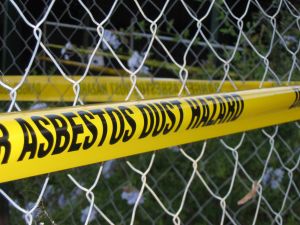 Every weekend in San Diego County, California, throngs of United States residents travel south across the border to Mexico, looking for bargains in Tijuana shopping malls. As the weekend ends, the line of cars coming back into the United States extends for miles. In 2005, 50 million people, and 17 million vehicles, traveled from Mexico, across the U.S. Border, into San Ysidro, California. There, U.S. Customs agents are tasked with trying to organize the mass exodus while at the same time protecting America from illicit drugs, human trafficking and terror threats. But recent reports from Mexico highlight a growing concern among public health and consumer safety advocates, that there is one menace that U.S. Customs agents are ill equipped to control. Consumers may be returning home to United States with products purchased in Mexico, that unbeknownst to them, contain a destructive poison indistinguishable to the naked eye, asbestos.
Every weekend in San Diego County, California, throngs of United States residents travel south across the border to Mexico, looking for bargains in Tijuana shopping malls. As the weekend ends, the line of cars coming back into the United States extends for miles. In 2005, 50 million people, and 17 million vehicles, traveled from Mexico, across the U.S. Border, into San Ysidro, California. There, U.S. Customs agents are tasked with trying to organize the mass exodus while at the same time protecting America from illicit drugs, human trafficking and terror threats. But recent reports from Mexico highlight a growing concern among public health and consumer safety advocates, that there is one menace that U.S. Customs agents are ill equipped to control. Consumers may be returning home to United States with products purchased in Mexico, that unbeknownst to them, contain a destructive poison indistinguishable to the naked eye, asbestos.
Asbestos is naturally occurring rock fiber that was widely used in the manufacturing of various construction products in the United States until the 1980’s, due to it’s heat repelling and fusing properties. Presently, over 1,800 Mexican businesses incorporate asbestos fibers as a component in their manufacturing processes. In the decade preceding 2010, over 200,000 metric tons of asbestos were consumed by Mexican Manufacturing Industry.
Some consumers mistakenly believe that asbestos is only used in insulation, or as part of heavy construction products.  However, in the past non-profit organizations have found asbestos contaminating common consumer products such as children fingerprint dusting kits, in talcum powders, toy clays kits, hair rollers, hot plates, hair dryers and decorative floor tiles. Moreover, asbestos contaminated vermiculite, sometimes used as a packing material for products, is also a public health concern.
However, in the past non-profit organizations have found asbestos contaminating common consumer products such as children fingerprint dusting kits, in talcum powders, toy clays kits, hair rollers, hot plates, hair dryers and decorative floor tiles. Moreover, asbestos contaminated vermiculite, sometimes used as a packing material for products, is also a public health concern.
In Mexico, asbestos is used to the manufacture asbestos cement pipes, care brakes, cement, roofing and drywall materials.
“Asbestos use is a public health threat to United States consumers traveling abroad to Mexico, but equally important, it is a threat to the citizens of Mexico. It is a travesty that the industrial use of asbestos has not been curtailed in Mexico.”, commented Asbestos Legal Center founder, Michael Mandelbrot, from his office in San Francisco.
When asbestos fibers are inhaled by humans, the microscopic fibers sometimes become lodged in the pleura of the lungs. Thereafter the body owns immune system is activated, trying to destroy the foreign asbestos body. Over time scarring develops at the site where the fiber is lodged. When that scarring becomes chronic, and grows in size, it can result in an obstructive pulmonary disease called asbestosis. Asbestosis patients labor to breathe as a result of the disease, and in sever advanced stages, cannot survive without the use of oxygen supplementation.
Other lung diseases that can develop from exposure to asbestos include lung cancer, and malignant pleural mesothelioma. Malignant pleural mesothelioma is an incurable disease that in most cases has an average life span of nine to twelve months. Individuals in California diagnosed with any asbestos related disease have the right to seek compensation for their injuries in the Court system…
If you are interested in learning more about your legal rights, the Asbestos Legal Center is now providing free legal consultations at 1-800-970-3878.
 Mesothelioma Lawyer Blog
Mesothelioma Lawyer Blog

